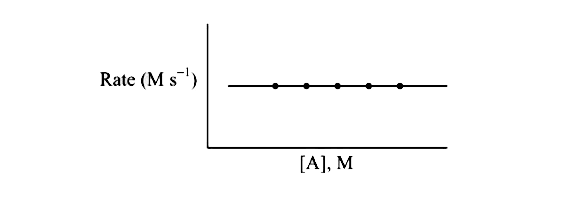The following data is given at 27∘C for the reaction xA+yB → product .Trial. [A]mol / L [B]mol/L Rate(Ms−1)10.010.0110−620.010.022×10−630.040.0232×10−6
If reaction is elementary,then select the correct relation.
(A) x=y+2
(B) y=x+2
(C)x=y
(D) x=y+1
Step by step video & image solution for The following data is given at 27^(@)C for the reaction xA+yB rarr product .{:("Trial. ",[A]"mol / L ",[B]"mol/L ","Rate (M s^(-1))),(1,0.01,0.01,10^(-6)),(2,0.01,0.02,2xx10^(-6)),(3,0.04,0.02,32xx10^(-6)):} If reaction is elementary,then select the correct relation.(A) x=y+2 (B) y=x+2 (C)x=y (D) x=y+1 by Chemistry experts to help you in doubts & scoring excellent marks in Class 12 exams.
Similar Questions
The following data are for the reaction A+B→ Products:
Conc.ofA(M)Conc.ofB(M)Initialrate(molL−1s−1)0.10.14.0×10−40.20.21.6×10−30.50.11.0×10−20.50.55.0×10−2
(a) What is the order with respect to A and B for the reaction?
(b) Calculate the rate constant
Determine the reaction rate when the concentrations of A and B are 0.2M and 0.35M respectvely.View SolutionCarbon monoxide reacts with O2 to form CO2: 2CO(g)+O2(g)→2CO2(g)
Infromations about this reaction are given in the table below.
[CO]mol/L[O2]mol/LRate of reaction (mol/L.min)0.020.024×10−50.040.021.6×10−40.020.048×10−5
What is the value for the rate constant for the reaction in properly related unit?View Solution
Knowledge Check
- Question 1 - Select One
The following data are obtained for a reaction, X+Y→Products.
Expt. [X0]/mol [Y0]/mol rate/mol L−1s−110.250.251.0×10−620.500.254.0×10−630.250.508.0×10−6
The overall of the reaction isA2B4C3D5 - Question 2 - Select One
In data given below.
[A][B]ratemol/Lmol/LmolL−1s−1a.0.021.23.0×10−3b.0.042.46.0×10−3
The reaction may beAFirst orderBSecond orderCPseudo second orderDSecond order w.r.t. A - Question 3 - Select One
In the following reaction , the initial concentration of the reactant and initial rate at 298 K are given
2A→C+D
[A]0molL−1Initial rate in molL−1s−10.015.0×10−50.022×10−4
The value of rate constant of this reaction at 298 K isA0.01s−1B5×10−3molL−1s−1C2.0×10−2mol−1Ls−1D5×10−1mol−1Ls−1
The equation of the tangent to the curve y=secx at the point (0,1) is
(a) y=0
(b) x=0
(c) y=1
(d) x=1View SolutionFollowing reaction can take place in both direction Ak1k2B. For the forward reaction and for the backward direction
[B]Rate0.01M1×10−2Ms−10.02M2×10−2Ms−1
Hence, net reaction rate is :
 View Solution
View SolutionRate of a reaction A+B→ Product, is given as a function of different initial concentration of A and B.
∣∣ ∣ ∣ ∣ ∣ ∣∣[A](molL−1)(B)(molL−1)Initial rate(molL−1−1min)0.010.010.0050.020.010.0100.010.020.005∣∣ ∣ ∣ ∣ ∣ ∣∣
Determine the order of the reaction with respect to A and with respect to B. What is the half life of A in the reaction ?View SolutionFind the values of A,B and C in the following table for the reaction X+Y→Z. The reaction is of first order w.r.t X and zero order w.r.t. Y.
Exp[X](molL−1)[Y](molL−1)Initialrate(molL−1s−1)10.10.12×10−22A0.24×10−230.40.4B4C0.22×10−2View SolutionFor the non-stoichiometric reaction 2A+B→C+D
The following kinetic data were obtained in theee separate experiment, all at 98K
∣∣ ∣ ∣ ∣ ∣∣Initial concentration (A)Initial concentration (B)Initial rate of formation of C(molL−1s−1)0.01M0.1M1.2×10−30.1M0.2M1.2×10−30.2M0.1M2.4×10−3∣∣ ∣ ∣ ∣ ∣∣
The rate law for the formation of C is:View Solution
